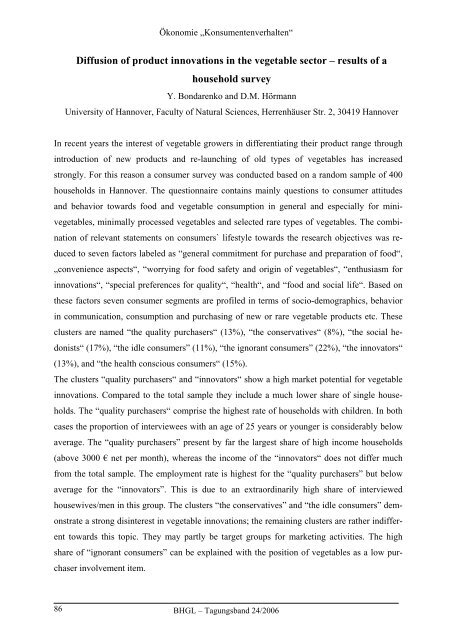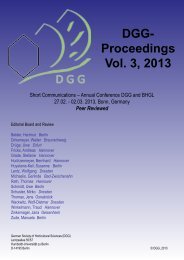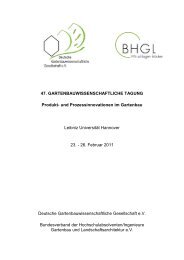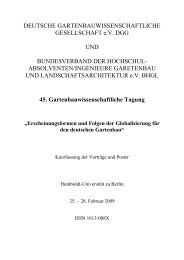43. Gartenbauwissenschaftliche Tagung - (DGG) und des
43. Gartenbauwissenschaftliche Tagung - (DGG) und des
43. Gartenbauwissenschaftliche Tagung - (DGG) und des
Sie wollen auch ein ePaper? Erhöhen Sie die Reichweite Ihrer Titel.
YUMPU macht aus Druck-PDFs automatisch weboptimierte ePaper, die Google liebt.
86<br />
Ökonomie „Konsumentenverhalten“<br />
Diffusion of product innovations in the vegetable sector – results of a<br />
household survey<br />
Y. Bondarenko and D.M. Hörmann<br />
University of Hannover, Faculty of Natural Sciences, Herrenhäuser Str. 2, 30419 Hannover<br />
In recent years the interest of vegetable growers in differentiating their product range through<br />
introduction of new products and re-launching of old types of vegetables has increased<br />
strongly. For this reason a consumer survey was conducted based on a random sample of 400<br />
households in Hannover. The questionnaire contains mainly questions to consumer attitu<strong>des</strong><br />
and behavior towards food and vegetable consumption in general and especially for minivegetables,<br />
minimally processed vegetables and selected rare types of vegetables. The combination<br />
of relevant statements on consumers` lifestyle towards the research objectives was reduced<br />
to seven factors labeled as “general commitment for purchase and preparation of food“,<br />
„convenience aspects“, “worrying for food safety and origin of vegetables“, “enthusiasm for<br />
innovations“, “special preferences for quality“, “health“, and “food and social life“. Based on<br />
these factors seven consumer segments are profiled in terms of socio-demographics, behavior<br />
in communication, consumption and purchasing of new or rare vegetable products etc. These<br />
clusters are named “the quality purchasers“ (13%), “the conservatives“ (8%), “the social hedonists“<br />
(17%), “the idle consumers” (11%), “the ignorant consumers” (22%), “the innovators“<br />
(13%), and “the health conscious consumers“ (15%).<br />
The clusters “quality purchasers“ and “innovators“ show a high market potential for vegetable<br />
innovations. Compared to the total sample they include a much lower share of single households.<br />
The “quality purchasers“ comprise the highest rate of households with children. In both<br />
cases the proportion of interviewees with an age of 25 years or younger is considerably below<br />
average. The “quality purchasers” present by far the largest share of high income households<br />
(above 3000 € net per month), whereas the income of the “innovators“ does not differ much<br />
from the total sample. The employment rate is highest for the “quality purchasers” but below<br />
average for the “innovators”. This is due to an extraordinarily high share of interviewed<br />
housewives/men in this group. The clusters “the conservatives” and “the idle consumers” demonstrate<br />
a strong disinterest in vegetable innovations; the remaining clusters are rather indifferent<br />
towards this topic. They may partly be target groups for marketing activities. The high<br />
share of “ignorant consumers” can be explained with the position of vegetables as a low purchaser<br />
involvement item.<br />
BHGL – <strong>Tagung</strong>sband 24/2006















